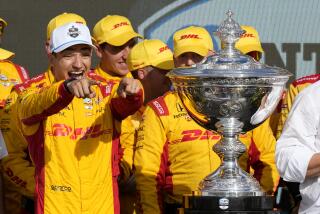NASCAR continues with its stonewall approach to information on seat-belt controversy.
- Share via
FONTANA — Perhaps someday, we all will know precisely what happened to Dale Earnhardt’s seat belt on Feb. 18, the day he was killed when his stock car crashed on the last turn of the last lap of the Daytona 500.
Today is not that day.
But thanks to a report Sunday in the Orlando Sentinel and other Tribune Co. papers, The Times among them, the number of possibilities is up to three:
* NASCAR, which runs Winston Cup stock car racing, was taking some heat about its approach to driver safety when it announced five days after Earnhardt’s death that his seat belt had broken in the crash. Then Dr. Steve Bohannon, medical director at Daytona International Speedway, theorized that the broken belt contributed to Earnhardt’s death by allowing his head to strike the steering wheel. NASCAR has never publicly shown the belt.
* Bill Simpson, whose company had made Earnhardt’s seat harness, stoutly defended his product, then eventually announced that he had a videotape, made by a fan, indicating that rescue workers had cut the belt. Simpson has never publicly shown the video in question.
* Then, in Sunday’s Sentinel story, rescue worker Tommy Propst, one of the first to reach Earnhardt in his wrecked car, said that the belt was intact when he and his partner began rescue procedures, that none of the emergency medical technicians cut it and that it was intact when Earnhardt was removed from the car.
NASCAR, in its peculiar noncommunicative manner, stuck to its guns in the wake of Propst’s disclosures.
“I have no response to that,” NASCAR President Mike Helton said after Sunday’s NAPA Auto Parts 500 at California Speedway. “We made a statement earlier today, and that’s all we’re going to do.”
Actually, there was no statement. What NASCAR did was call in Mike Harris, national motor-sports writer for the Associated Press, to discuss the situation with him and rely on him to disseminate its viewpoint.
According to Harris, Gary Nelson, NASCAR’s director of Winston Cup racing, said, “Our account doesn’t agree with [Propst’s]. There’s an inconsistency there.
“To my knowledge, the only person in the car was the female [EMT, possibly Patti Dobler, whom Propst had said had climbed into the car] and a man was outside and kneeling in the other window.
“When the woman tried to unhook his belts, she said she didn’t find the buckle in the usual place. They searched for it and found it wedged over at one side. They said the buckle was out of place and the belt seemed loose.”
Asked when NASCAR knew that the belt was broken, Nelson said he had discovered it the morning after the accident. He said the wrecked car had been covered with a tarp and locked in a garage, then later moved into a car hauler, which also then was locked.
He said he and his assistant, Steve Peterson, went to inspect the car Monday morning with the medical examiner and that was when he saw the short end of the belt. He said he asked the fire chief, also there, if the belt had been cut and was told by the chief, “Not to my knowledge.”
Nelson also said that from the time the car was covered until the inspection the next morning, a police officer and a NASCAR employee had it under observation.
In the Sentinel story, another rescue worker, Fire Rescue Lt. Mark Ratta, recalled seeing three men approach the car and pull the covering tarp aside. Then, Ratta said, at least one of them took flash photographs of the car’s interior.
Ratta said he’d assumed they were representatives of the police department or medical examiner’s office, but those agencies said they took no pictures that night.
NASCAR’s Nelson is right about one thing--there is an inconsistency here. Several, in fact.
The significance of the belt, whether broken, cut or neither, is not what it had to do with Earnhardt’s death. A court-appointed biomedical expert, Barry Myers of Duke University, determined in an independent study of the autopsy photos that even if the belt broke, it did its job and that Earnhardt had died of a basilar skull fracture, caused by severe whiplash, the same type of injury that had killed three other NASCAR drivers in the preceding eight months.
The significance of the belt, whether broken, cut or neither, goes to NASCAR’s credibility.
The organization has announced its own investigation into the crash but has repeatedly refused to disclose details of that investigation, or even the names of the people who presumably are involved in it.
“I don’t know of anybody that does a big investigation and tells the world their conclusions on a daily basis,” NASCAR Chairman Bill France Jr. said to Harris.
The organization says it is deep into safety research but has repeatedly refused to disclose details of that research. NASCAR also has not mandated use of head-and-neck safety devices, designed to protect drivers from the kind of head injury that killed Earnhardt and others, although some racing organizations require them. Until recently, NASCAR didn’t even recommend the devices.
The organization says . . . Well, actually, it says darn little. Too bad. One of these days, the drivers might get the idea that NASCAR doesn’t care quite as much about their welfare as it protests it does. Or that NASCAR is not quite as honest as it says it is.
Then what?
More to Read
Go beyond the scoreboard
Get the latest on L.A.'s teams in the daily Sports Report newsletter.
You may occasionally receive promotional content from the Los Angeles Times.










